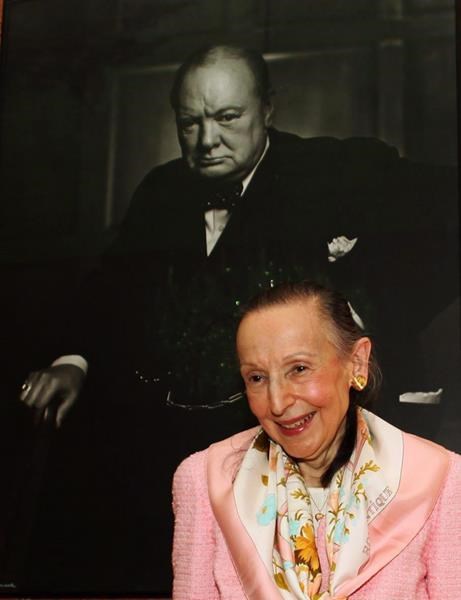Art
Two art heists, 50 years apart: expert says Canada is a ‘soft target’

OTTAWA — It’s not clear how they did it: was it a clandestine operation, carried out under the cloak of darkness? An elaborate ruse, designed to fool onlookers? Or something else?
However it happened, it’s clear those who stole a world-famous portrait of Sir Winston Churchill from the Château Laurier planned the heist meticulously.
It took more than eight months for anyone to realize the photo hanging from the wood-panelled walls of the Reading Lounge was a fake.
“It was very premeditated,” said Bonnie Czegledi, an Ontario lawyer who specializes in international art and cultural heritage law.
Art heists don’t surprise Czegledi, but she was surprised to hear this portrait was stolen, “because the subject matter is so specific.”
Even those who have dedicated decades to studying Churchill’s legacy are baffled.
Historian Andrew Roberts, who wrote a biography of the former British prime minister, called it “a rather bizarre story.”
“It is not a Picasso,” said Ron Cohen, president of the Sir Winston Churchill Society of Ottawa.
“That said … I do believe that it is probably the most famous single photograph of any political individual, ever. I think it’s an extraordinary piece.”
The portrait has a significant connection to the Château Laurier itself. The photographer, Yousuf Karsh, lived in the hotel for 18 years. It was home to his studio for 20 years.
When Churchill made a wartime speech to Canada’s Parliament in 1941, Karsh was asked by then-prime minister William Lyon Mackenzie King to take his portrait.
The resulting image of Churchill standing with one hand on a chair, another on his waist, scowling into the camera, captured the mood of the Allied nations. He appears defiant and determined. Scholars say the photo steeled the Allies’ resolve.
The Karsh Estate says the photographer’s entire portfolio of 350,000 prints and negatives was turned over to Library and Archives Canada upon his death in 1992, and no further copies were to be made.
Still, this not the only copy in existence — it’s not even the only original.
Sotheby’s in London had one up for auction in 2020, valued between US$20,000 and $26,000. The auction house declined to disclose the final price.
Ottawa’s Rideau Club has another in its Churchill Room.
One more hangs in the chamber of the Speaker of the House of Commons, near the very spot it was taken.
Richard Langworth, a senior fellow at the Hillsdale College Churchill Project in New Hampshire, said he can’t understand what was “so singular” about this particular portrait.
“Why bother?” he said. “And then to replace it with a fake?”
Several experts believe the thieves had a specific buyer in mind.
“That’s the organized crime business model,” Czegledi said.
Photos taken by guests have enabled hotel management to narrow down the timing of the theft to a 12-day period between Christmas Day and Jan. 6.
No surprise there, Czegledi said.
“Holidays like Christmas and New Year’s are very high risk for art crime and art theft because people are preoccupied with other things.”
The story has captured the imaginations of many around the world. It’s not every day an art heist happens in one of the most well-known buildings in the national capital.
Oddly, the timing of its discovery last week is almost 50 years after the largest art heist in Canadian history was pulled off in Montreal.
Known as the Skylight Caper, the story reads like a movie script.
On Sept. 4, 1972, a man scaled a tree near the Museum of Fine Arts in the middle of the night. He lowered a ladder from the roof to two others, who made their way to a skylight that was under repair.
A disabled security system allowed them to open the skylight, drop a 15-metre-long rope inside and shimmy down the onto the second floor.
They bound and gagged three security guards, with one thief holding them at gunpoint as the others went through the museum and gathered up 55 pieces. Among them were 17 paintings, including a Rembrandt.
“A spokesperson for the museum (at the time) had said that they had very discriminating taste,” Czegledi said.
What followed was equally theatrical: a ransom demand, including an envelope full of photos sent as proof of possession to the museum’s director; the return of a stolen locket, left in a phone booth; the return of a painting by Breughel the Elder, left in a train station locker; and plans for a secret rendezvous with the thieves.
In the end nothing more was recovered and no one was arrested.
“The problem is that the beauty of these objects detracts from the seriousness of the crime,” Czegledi said.
“There’s this preconceived notion that it’s just fluff, but it’s not. It’s serious business.”
The Canadian Heritage Department said in a statement that art trafficking has “evolved from a cultural issue, to one of transnational organized crime and as a source of financing for terrorist groups.”
“It can be looked at as a matter of national security,” Czegledi said. “We’re seeing some terrorists and organized crime diversifying their portfolio in the art world.”
Canada does not keep specific statistics on art theft, instead lumping it in with all other manner of property theft.
Czegledi said that amounts to a poor understanding of both the scope of the problem and the intangible value of art.
In the United States, the Federal Bureau of Investigation has a specially trained unit dedicated to art theft. The only place in Canada with something similar is Quebec, which set up its own unit in 2008.
Canada doesn’t have specific anti-money laundering laws for art, unlike the U.K.
Czegledi said more robust investigation and prosecution would go a long way, as would sentencing guidelines for judges who might not understand the art world.
“Because of the atmosphere here, we’re a soft target.”
Canada has signed on to a United Nations convention banning the import of cultural property illegally exported from another state that is a party to the convention.
But the United States requires separate agreements with individual countries regulating the movement of cultural materials. It has deals in place with more than two dozen countries. The agreement with Canada expired two decades ago.
“A request by Canada for renewal of the agreement upon its expiry in 2002 was unsuccessful,” a spokesperson for Canadian Heritage said, adding that law enforcement agencies work together on an ad hoc basis.
Czegledi said it’s tragic that art theft continues. “How many lessons do we need to have, to learn?”
This report by The Canadian Press was first published Aug. 27, 2022.
Sarah Ritchie, The Canadian Press
Art
Ukrainian sells art in Essex while stuck in a warzone – BBC.com
[unable to retrieve full-text content]
Ukrainian sells art in Essex while stuck in a warzone BBC.com

Source link
Art
Somerset House Fire: Courtauld Gallery Reopens, Rest of Landmark Closed
The Courtauld Gallery at Somerset House has reopened its doors to the public after a fire swept through the historic building in central London. While the gallery has resumed operations, the rest of the iconic site remains closed “until further notice.”
On Saturday, approximately 125 firefighters were called to the scene to battle the blaze, which sent smoke billowing across the city. Fortunately, the fire occurred in a part of the building not housing valuable artworks, and no injuries were reported. Authorities are still investigating the cause of the fire.
Despite the disruption, art lovers queued outside the gallery before it reopened at 10:00 BST on Sunday. One visitor expressed his relief, saying, “I was sad to see the fire, but I’m relieved the art is safe.”
The Clark family, visiting London from Washington state, USA, had a unique perspective on the incident. While sightseeing on the London Eye, they watched as firefighters tackled the flames. Paul Clark, accompanied by his wife Jiorgia and their four children, shared their concern for the safety of the artwork inside Somerset House. “It was sad to see,” Mr. Clark told the BBC. As a fan of Vincent Van Gogh, he was particularly relieved to learn that the painter’s famous Self-Portrait with Bandaged Ear had not been affected by the fire.
Blaze in the West Wing
The fire broke out around midday on Saturday in the west wing of Somerset House, a section of the building primarily used for offices and storage. Jonathan Reekie, director of Somerset House Trust, assured the public that “no valuable artefacts or artworks” were located in that part of the building. By Sunday, fire engines were still stationed outside as investigations into the fire’s origin continued.
About Somerset House
Located on the Strand in central London, Somerset House is a prominent arts venue with a rich history dating back to the Georgian era. Built on the site of a former Tudor palace, the complex is known for its iconic courtyard and is home to the Courtauld Gallery. The gallery houses a prestigious collection from the Samuel Courtauld Trust, showcasing masterpieces from the Middle Ages to the 20th century. Among the notable works are pieces by impressionist legends such as Edouard Manet, Claude Monet, Paul Cézanne, and Vincent Van Gogh.
Somerset House regularly hosts cultural exhibitions and public events, including its popular winter ice skating sessions in the courtyard. However, for now, the venue remains partially closed as authorities ensure the safety of the site following the fire.
Art lovers and the Somerset House community can take solace in knowing that the invaluable collection remains unharmed, and the Courtauld Gallery continues to welcome visitors, offering a reprieve amid the disruption.
Art
Sudbury art, music festival celebrating milestone

Sudbury’s annual art and music festival is marking a significant milestone this year, celebrating its long-standing impact on the local cultural scene. The festival, which has grown from a small community event to a major celebration of creativity, brings together artists, musicians, and visitors from across the region for a weekend of vibrant performances and exhibitions.
The event features a diverse range of activities, from live music performances to art installations, workshops, and interactive exhibits that highlight both emerging and established talent. This year’s milestone celebration will also honor the festival’s history by showcasing some of the artists and performers who have contributed to its success over the years.
Organizers are excited to see how the festival has evolved, becoming a cornerstone of Sudbury’s cultural landscape. “This festival is a celebration of creativity, community, and the incredible talent we have here in Sudbury,” said one of the event’s coordinators. “It’s amazing to see how it has grown and the impact it continues to have on the arts community.”
With this year’s milestone celebration, the festival promises to be bigger and better than ever, with a full lineup of exciting events, workshops, and performances that will inspire and engage attendees of all ages.
The festival’s milestone is not just a reflection of its past success but a celebration of the continued vibrancy of Sudbury’s arts scene.

-

 Sports17 hours ago
Sports17 hours agoLawyer says Chinese doping case handled ‘reasonably’ but calls WADA’s lack of action “curious”
-

 Sports24 hours ago
Sports24 hours agoCanada’s Michael Woods rethinks retirement, targets Montreal win after Vuelta triumph
-

 News16 hours ago
News16 hours agoB.C. to scrap consumer carbon tax if federal government drops legal requirement: Eby
-

 News17 hours ago
News17 hours agoRCMP say 3 dead, suspects at large in targeted attack at home in Lloydminster, Sask.
-

 News16 hours ago
News16 hours agoA linebacker at West Virginia State is fatally shot on the eve of a game against his old school
-

 News17 hours ago
News17 hours agoCeiling high for Vancouver Whitecaps midfielder Ahmed: Canada coach
-

 Sports3 hours ago
Sports3 hours agoDavid Beckham among soccer dignitaries attending ex-England coach Sven-Goran Eriksson’s funeral
-

 Sports2 hours ago
Sports2 hours agoDolphins will bring in another quarterback, while Tagovailoa deals with concussion






























